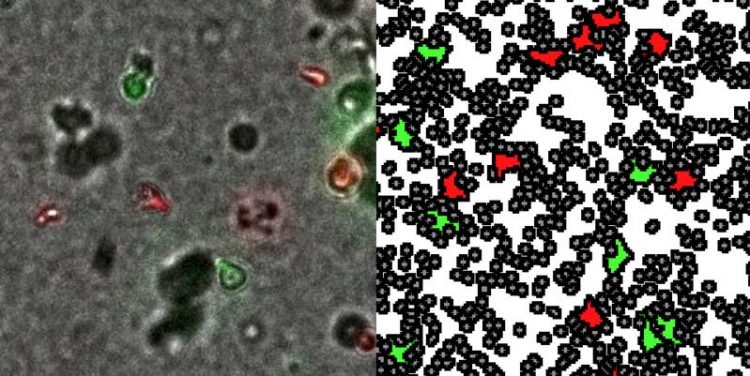HIV Spreads Through Direct Cell-To-Cell Contact

Microscopic recording and computer model of the interaction between infected cells (green) and non-infected cells (red) in collagen structures (grey). Source: Oliver Fackler / Frederik Graw
HIV Spreads Through Direct Cell-To-Cell Contact
Researchers investigate infection dynamics in tissue-like three-dimensional cell cultures
The spread of pathogens like the human immunodeficiency virus (HIV) is often studied in a test tube, i.e. in two-dimensional cell cultures, even though it hardly reflects the much more complex conditions in the human body.
Using innovative cell culture systems, quantitative image analysis, and computer simulations, an interdisciplinary team of scientists from Heidelberg University has now explored how HIV spreads in three-dimensional tissue-like environments. The researchers’ results show that the tissue structure forces the virus to spread through direct cell-to-cell contact.
Despite over 30 years of research, many key aspects of how HIV, the causative agent of the acquired immune deficiency syndrome (AIDS) spreads are still not understood.
One of these unresolved questions concerns the interactions between the virus with the environment in the human body. Traditionally it has been assumed that infected cells release viral particles which then diffuse and eventually infect other cells.
But it is also possible that viral particles are directly transferred from one infected cell to the next through close contact. Until now it was unknown which of these modes of transmission prevailed in tissue.
“Studies on HIV replication in the lab are mostly conducted in simple cell culture experiments in plastic dishes that do not reflect the complex architecture and heterogeneity of tissue”, explains study director Prof. Dr Oliver Fackler of the Center for Integrative Infectious Disease Research (CIID) at Heidelberg University Hospital.
In their approach, the Heidelberg researchers took into account that the so-called CD4 T helper cells, the preferred cell type infected by HIV, are highly motile in their physiological environment. They used a novel cell culture system, in which a three-dimensional scaffold was generated with the help of collagen.
This allowed for maintaining the cells’ mobility and monitoring primary CD4 T cells infected with HIV-1 in a tissue-like environment over the course of several weeks. Using this innovative approach, the researchers measured a number of factors that characterise cell motility, virus replication, and the gradual loss of CD4 T helper cells.
“This yielded a very complex set of data that was impossible to interpret without the help from scientists of other disciplines”, explains Dr Andrea Imle, who worked on the project during her PhD at the CIID.
In analysing the data, the scientists who conducted the experiments collaborated with colleagues from the fields of image processing, theoretical biophysics and mathematical modelling. Together they were able to characterise the complex behaviour of cells and viruses and simulate it on the computer.
This made it possible to make important predictions on the key processes that determine HIV-1 spread in these 3D cultures, which were confirmed by subsequent experimentation. “Our interdisciplinary study is a good example of how iterative cycles of experimentation and simulation can help to quantitatively analyse a complex biological process”, states Prof. Dr Ulrich Schwarz of the Institute for Theoretical Physics at Heidelberg University.
The data analysis revealed that the 3D environment of the cell culture system suppresses infection with a cell-free virus while simultaneously promoting direct virus transmission from cell to cell. “Our models allowed us to integrate short single-cell microscopy films with long-term cell population measurements and thereby to estimate the minimal time span required for cell-to-cell contacts to transmit infection”, explains Dr Frederik Graw of the BioQuant Centre of Heidelberg University. The researchers hope that these findings will eventually lead to new therapeutic approaches in the treatment of HIV.
The research was conducted within the Collaborative Research Centre “Integrative Analysis of Pathogen Replication and Spread” (CRC 1129) funded by the German Research Foundation and supported by the Center for Modelling and Simulation in the Biosciences (BIOMS) of Heidelberg University. The results were published in “Nature Communications”.
Contact:
Heidelberg University
Communications and Marketing
Press Office, phone +49 6221 54-2311
presse@rektorat.uni-heidelberg.de
Prof. Dr Oliver Fackler
Center for Integrative Infectious Disease Research (CIID)
Phone +49 6221 56-1322
oliver.fackler@med.uni-heidelberg.de
Dr Frederik Graw
BioQuant Center
Phone +49 6221 54-51309
frederik.graw@bioquant.uni-heidelberg.de
Prof. Dr Ulrich Schwarz
Institute for Theoretical Physics
Phone +49 6221 54-9399
schwarz@thphys.uni-heidelberg.de
A. Imle, P. Kumberger, N.D. Schnellbächer, J. Fehr, P. Carrillo-Bustamante, J. Ales, P. Schmidt, C. Ritter, W.J. Godinez, B. Müller, K. Rohr, F.A. Hamprecht, U.S. Schwarz, F. Graw & O. T. Fackler: Experimental and computational analyses reveal that environmental restrictions shape HIV-1 spread in 3D cultures. Nature Communications (2019) 10:2144, https://doi.org/10.1038/s41467-019-09879-3
Media Contact
All latest news from the category: Life Sciences and Chemistry
Articles and reports from the Life Sciences and chemistry area deal with applied and basic research into modern biology, chemistry and human medicine.
Valuable information can be found on a range of life sciences fields including bacteriology, biochemistry, bionics, bioinformatics, biophysics, biotechnology, genetics, geobotany, human biology, marine biology, microbiology, molecular biology, cellular biology, zoology, bioinorganic chemistry, microchemistry and environmental chemistry.
Newest articles

High-energy-density aqueous battery based on halogen multi-electron transfer
Traditional non-aqueous lithium-ion batteries have a high energy density, but their safety is compromised due to the flammable organic electrolytes they utilize. Aqueous batteries use water as the solvent for…

First-ever combined heart pump and pig kidney transplant
…gives new hope to patient with terminal illness. Surgeons at NYU Langone Health performed the first-ever combined mechanical heart pump and gene-edited pig kidney transplant surgery in a 54-year-old woman…

Biophysics: Testing how well biomarkers work
LMU researchers have developed a method to determine how reliably target proteins can be labeled using super-resolution fluorescence microscopy. Modern microscopy techniques make it possible to examine the inner workings…





















